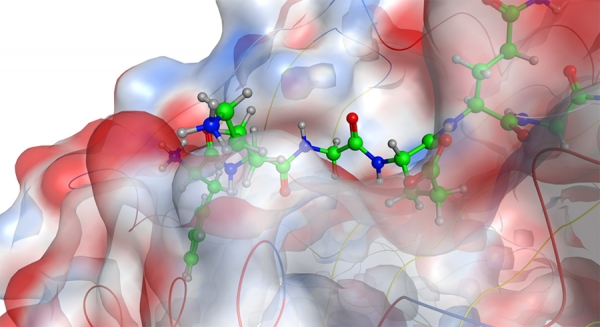 This computer-rendered graphic shows a peptide bound to a protein. Image courtesy the Trant Team, University of Windsor.
This computer-rendered graphic shows a peptide bound to a protein. Image courtesy the Trant Team, University of Windsor.
Drug discovery research can get complicated quickly and John Trant, associate professor of chemistry and biochemistry, wants to simplify the process.
When designing a potential new drug, researchers cannot look at all the possible combinations of molecules ― there are more possible “small molecule” drugs than there are atoms in the universe. But that isn’t the case for small parts of proteins called peptides.
Dr. Trant and his team have created an open-access computational tool that simplifies the process of investigating potential peptide drugs and recently published it in the Journal of Pharmaceutical Analysis. They previously posted an earlier version of the paper to the open-access repository ChemRxiv.
“This easy-to-use computational tool we’ve released will help people around the world who are trying to do peptide drug discovery,” says Dr. Trant.
“Peptide-based therapeutics are increasingly pushing to the forefront of biomedicine with their promise of high specificity and low toxicity.”
In the revolution of drug discovery for the last 45 to 50 years, Trant says, small molecules are great. But the way they work, the molecule needs to sit in a groove to bind, a handle to grab onto: “we call those druggable pockets,” Trant says.
Not all target proteins, like some virus particles, have a groove to bind to. These “undruggable” proteins have a lot of flat surfaces they use to interact with other proteins. Normal small molecules are not great at binding to them, but peptides that imitate proteins have a good chance. These peptides are short chains of the same amino acids that are the building blocks of proteins.
“The big movement is to use peptide-based drugs because peptides are amino acids and proteins are amino acids,” Trant says.
He and his team, post-doctoral researchers Muhammad Usman Mirza and Sarfraz Ahmad, designed the computer simulation research tool, which looks at all combinations up to a maximum chain of five amino acids. Trant says there are a lot of drugs made up of five amino acids, or that have a key core of only four or five amino acids.
“We’re really excited that if you know where you want your peptide-based drug to bind, we can now look at every possibility out there because there are only 20 natural amino acids. It is a manageable number,” he says.
“For the first time ever, we’ve prepared a library of all 3.2 million linear peptide combinations, and we have made it open source so that anyone, anywhere, can use this tool to accelerate their own research.”
As a case study, the developed library was screened against the SARS-CoV-2 main protease to identify potential small peptide inhibitors. This is a key protein that allows COVID-19 to infect humans.
“We used our tool to screen every possible peptide against the main protease of SARS-CoV-2,” says Trant.
After screening the 3.2 million combinations, the team came up with molecules that are the same sequences as those found previously by experimental researchers.
“Our computer model works. It matches. It binds the right molecules,” Trant says.
“We think this is a way to accelerate drug discovery because it took us an afternoon to look at all these peptides against SARS-CoV-2, whereas it took a lot longer for others to do this experimentally.”
Some peptide drug candidates the team found and predicted to be far better drugs than those identified by others have been sent to a research lab in Belgium where they will be tested against SARS-CoV-2.
“In addition to being a more manageable when looking at possible combinations, we’re interested in peptides because this is new chemistry, which can lead to new drugs,” says Trant.
“We are now building out this tool in a few different ways to allow it to help discover far more complicated peptide-based drugs, and we are really excited with what it is allowing us to do.”
The open-access research tool is available on the Canadian research data repository Borealis.
—Sara Elliott
